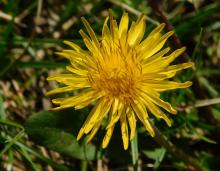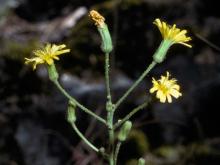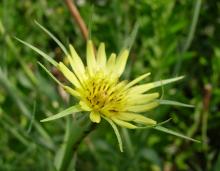Wildflowers, Grasses and Other Nonwoody Plants
Media

Species Types
Scientific Name
Taraxacum officinale
Description
The common dandelion is a well-known common weed of lawns, roadsides, and other disturbed places. Originally from Europe, it occurs nearly worldwide.
Media

Species Types
Scientific Name
Euphorbia esula
Description
When you consider the negative effects this plant has on natural habitats, and how hard it is to control or eradicate, you almost want to rename it “leafy scourge”! This invasive plant is spreading in our state. Learn how to identify it.
Media

Species Types
Scientific Name
Pyrrhopappus carolinianus
Description
One of several native plants called dandelions, Carolina false dandelion is an annual with sulphur yellow flowers and puffy seedheads.
Media

Species Types
Scientific Name
Krigia biflora
Description
There are several members of the aster family that look something like common dandelions. But unlike the familiar lawn weed, two-flowered Cynthia is a native Missouri wildflower.
Media

Species Types
Scientific Name
Hieracium gronovii
Description
A native wildflower of forests, blufftops, glades, pastures, and roadsides, beaked hawkweed looks something like a hairy, yellow-flowering chicory. It is found mostly south of the Missouri River.
Media

Species Types
Scientific Name
Tragopogon dubius
Description
With its yellow composite flowers and round seedheads of fluffy “parachutes,” goat’s beard looks like a gigantic dandelion. A native of Europe, many people view it as an invasive weed.
Media

Species Types
Scientific Name
Asclepias viridis
Description
The flower clusters of green-flowered or spider milkweed bear large flowers for a milkweed. The jazzy purple hoods are dazzling against the greenish-yellow petals.
Media

Species Types
Scientific Name
Euphorbia commutata
Description
Conspicuous in early spring, wood spurge is a dainty species with loose clusters of small, light green flowers. Look for it in woods, valleys, streamsides, and waste areas in Ozark landscapes.
Media

Species Types
Scientific Name
Subfamily Asclepiadoideae
Description
Milkweeds are a group of plants that used to have their very own family. Now part of the dogbane family, they’re still a pretty distinctive group.
See Also
About Wildflowers, Grasses and Other Nonwoody Plants in Missouri
A very simple way of thinking about the green world is to divide the vascular plants into two groups: woody and nonwoody (or herbaceous). But this is an artificial division; many plant families include some species that are woody and some that are not. The diversity of nonwoody vascular plants is staggering! Think of all the ferns, grasses, sedges, lilies, peas, sunflowers, nightshades, milkweeds, mustards, mints, and mallows — weeds and wildflowers — and many more!





















